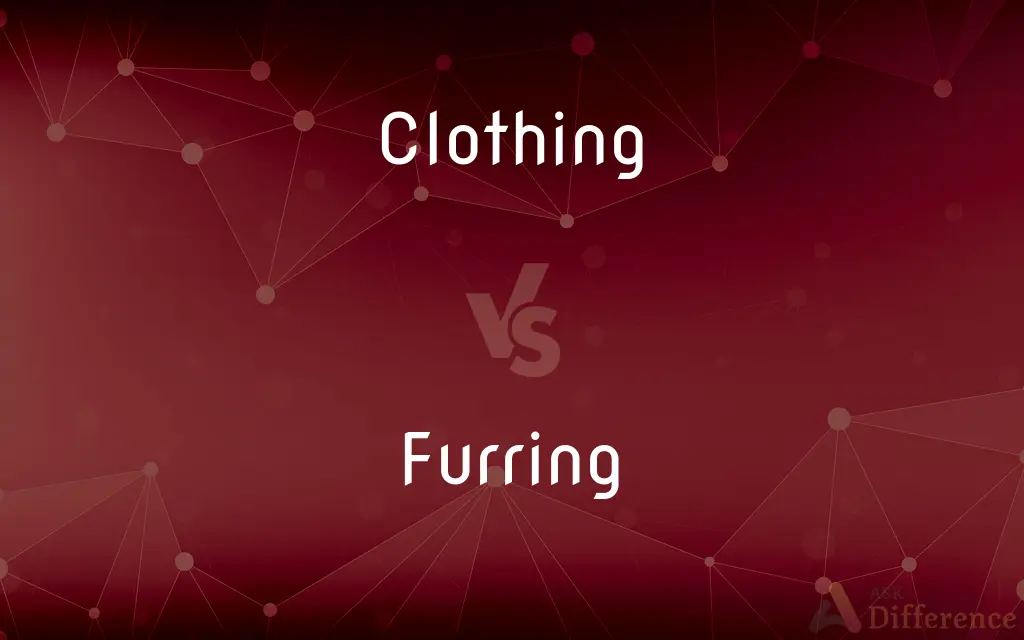Clothing vs. Furring — What's the Difference?
Edited by Tayyaba Rehman — By Maham Liaqat — Updated on April 4, 2024
Clothing refers to garments worn on the body for protection or adornment, while furring involves adding a layer of material to walls or ceilings for insulation or to create a level surface.

Difference Between Clothing and Furring
Table of Contents
ADVERTISEMENT
Key Differences
Clothing is designed to be worn by individuals, providing both functionality and a means of expressing personal style. It serves various purposes, from protecting the body against different weather conditions to adhering to social and cultural norms. On the other hand, furring is a construction technique that involves attaching strips of wood or metal to walls or ceilings. This process creates a space for insulation, helps to conceal imperfections, and provides a flat surface for finishing materials.
The materials used in clothing and furring are distinctly different. Clothing is made from a wide range of materials including fabrics like cotton, wool, silk, and synthetic fibers, chosen for their comfort, durability, and appearance. Conversely, furring materials are typically more rigid, including wood furring strips, metal channels, or plastic spacers, selected for their structural properties and compatibility with building materials.
From a functional perspective, clothing is intimately linked with the human body, designed to fit and move with it, while also reflecting cultural and individual identities. Furring, however, serves a structural purpose in construction, aimed at improving the energy efficiency of buildings, facilitating the installation of utilities, and enhancing the final appearance of walls and ceilings.
The process of selecting clothing can be deeply personal, influenced by an individual's taste, the occasion, and the current fashion trends. In contrast, the choice to use furring in construction is determined by building codes, architectural requirements, and the specific needs of a project, such as soundproofing or thermal insulation.
Clothing and furring also differ in their historical and cultural significance. Clothing has been an essential part of human civilization for thousands of years, evolving with societies and carrying deep symbolic meanings related to status, profession, and identity. Furring, while practical in nature, does not carry the same depth of cultural significance but reflects advancements in building technology and architectural design.
ADVERTISEMENT
Comparison Chart
Purpose
Worn on the body for protection and style.
Creates space for insulation and levels surfaces.
Materials
Fabrics like cotton, wool, silk, synthetic fibers.
Wood strips, metal channels, plastic spacers.
Functionality
Protects body, expresses personal style.
Improves energy efficiency, conceals imperfections.
Selection Process
Influenced by personal taste, occasion, trends.
Determined by building codes, architectural needs.
Cultural Significance
Reflects status, identity, and societal norms.
Reflects advancements in building technology.
Compare with Definitions
Clothing
Fashion Trends.
Fashion trends significantly influence clothing choices and designs.
Furring
Insulation Support.
Furring strips create space behind drywall for insulation.
Clothing
Personal Expression.
Clothing allows individuals to express their personality and style.
Furring
Architectural Requirement.
Furring is often required by building codes for certain finishes.
Clothing
Cultural Symbolism.
Certain garments can signify cultural heritage, profession, or social status.
Furring
Construction Technique.
Furring is used in construction to level out walls and ceilings.
Clothing
Diverse Materials.
From silk blouses to denim jeans, clothing uses a variety of materials for different effects.
Furring
Soundproofing.
Adding furring can improve a room’s soundproofing capabilities.
Clothing
Protective Function.
Winter coats protect against cold, while hats shield from the sun.
Furring
Material Specificity.
Metal furring channels are preferred for moisture resistance.
Clothing
Clothing (also known as clothes, apparel, and attire) are items worn on the body. Typically, clothing is made of fabrics or textiles, but over time it has included garments made from animal skin and other thin sheets of materials and natural products found in the environment, put together.
Furring
In construction, furring (furring strips) are thin strips of wood or other material to level or raise surfaces of another material to prevent dampness, to make space for insulation, or to level and resurface ceilings or walls. Furring refers to the process of installing the strips and to the strips themselves.
Clothing
Clothes considered as a group; wearing apparel.
Furring
Trimming or lining made of fur.
Clothing
A covering.
Furring
A furlike coating, as on the tongue.
Clothing
Present participle of clothe
Furring
The preparation of a wall, ceiling, or floor with strips of wood or metal to provide a level substratum for plaster, flooring, or another surface or to create an air space.
Clothing
Any of a wide variety of articles, usually made of fabrics, animal hair, animal skin, or some combination thereof, used to cover the human body for warmth, to preserve modesty, or for fashion.
You should wear warm clothing when it is cold outside.
All but two pieces of clothing came out of the washing machine stained.
A poncho is an item of clothing used by many people in Latin America.
A shirt is an article of clothing that covers the torso and arms.
Furring
Strips of material used in this process.
Clothing
An act or instance of putting clothes on.
The clothing and unclothing of the idols was of special significance.
Furring
Present participle of fur
Clothing
(obsolete) The art or process of making cloth.
Furring
Parts of clothing made from fur.
Clothing
A covering of non-conducting material on the outside of a boiler, or steam chamber, to prevent radiation of heat.
Furring
A coating that resembles fur.
A furring of the tongue
Clothing
Garments in general; clothes; dress; raiment; covering.
From others he shall stand in need of nothing,Yet on his brothers shall depend for clothing.
As for me, . . . my clothing was sackloth.
Furring
A strip of material used to prepare a wall for plastering, or to provide an air space.
Clothing
The art of process of making cloth.
Instructing [refugees] in the art of clothing.
Furring
(shipbuilding) Double planking of a ship's side.
Clothing
A covering of non-conducting material on the outside of a boiler, or steam chamber, to prevent radiation of heat.
Furring
Double planking of a ship's side.
Clothing
See Card clothing, under 3d Card.
Furring
A deposit from water, as on the inside of a boiler; also, the operation of cleaning away this deposit.
Clothing
A covering designed to be worn on a person's body
Furring
A furlike coating of matter as on the tongue
Furring
Strip used to give a level surface for attaching wallboard
Common Curiosities
What is clothing?
Garments worn on the body for protection, comfort, or adornment.
What materials are used in clothing?
Clothing can be made from natural fibers like cotton and silk or synthetic materials.
What is furring in construction?
A technique that involves attaching strips or channels to walls or ceilings to create a level surface or space for insulation.
Why is furring used in construction?
To create a flat surface for finishing, provide space for insulation, or conceal imperfections.
Are there different types of furring?
Yes, including wood furring strips and metal channels, chosen based on structural needs.
How has clothing evolved over time?
Clothing has evolved significantly, reflecting changes in society, technology, and fashion.
How do fashion trends affect clothing?
Trends influence the styles, materials, and designs of clothing available and worn.
What role does furring play in soundproofing?
Furring can enhance soundproofing by creating a space for sound-dampening materials.
Is furring visible in finished buildings?
No, furring is concealed behind the final wall or ceiling surfaces.
How do the purposes of clothing and furring differ?
Clothing is for personal wear, reflecting style and providing protection, while furring serves a structural role in buildings.
How is clothing selected?
Based on personal preference, occasion, and current fashion trends.
Does furring aid in insulation?
Yes, it creates a space for insulation materials, improving a building's energy efficiency.
Can clothing have cultural significance?
Yes, clothing often carries meanings related to status, identity, and cultural heritage.
What's the significance of materials in furring?
Materials are selected for structural integrity, moisture resistance, and compatibility with insulation.
Is the choice of clothing purely personal?
While personal taste plays a big role, social norms, cultural practices, and practical considerations also influence clothing choices.
Share Your Discovery

Previous Comparison
Ivory vs. White
Next Comparison
Differential vs. DifferenceAuthor Spotlight
Written by
Maham LiaqatEdited by
Tayyaba RehmanTayyaba Rehman is a distinguished writer, currently serving as a primary contributor to askdifference.com. As a researcher in semantics and etymology, Tayyaba's passion for the complexity of languages and their distinctions has found a perfect home on the platform. Tayyaba delves into the intricacies of language, distinguishing between commonly confused words and phrases, thereby providing clarity for readers worldwide.
















































